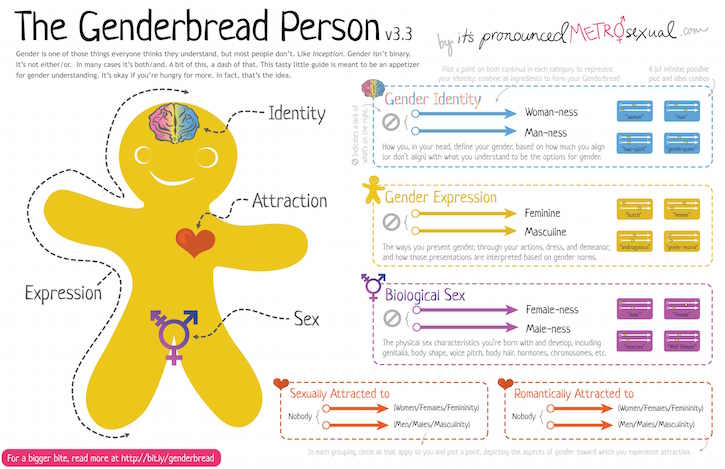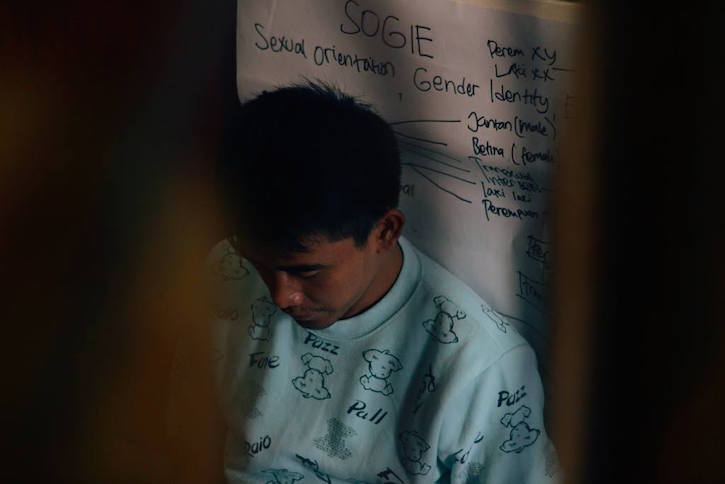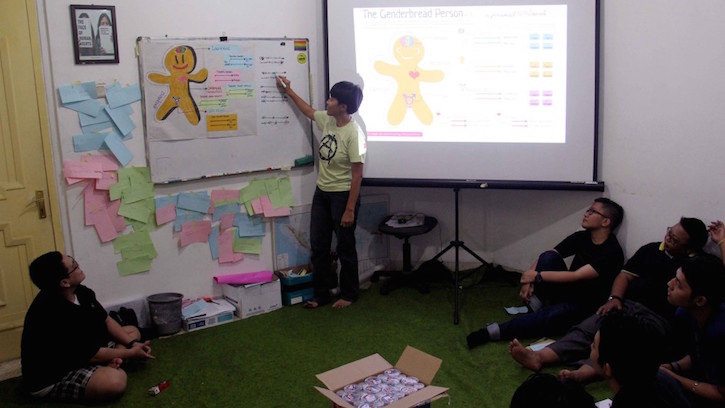An Indonesian transsexual movement faces challenges from within, as well as from without
Danny Gordon
A movement is emerging in Indonesia. Trans* (an umbrella term for all identities within the gender identity spectrum) female-to-male people are beginning to come together through various support groups, LGBTI organisations and online communities and are developing an emergent political voice. For many, it’s not a moment too soon. While development agencies and government departments are paying increasing attention to gender, they often overlook the challenges facing citizens who cannot be clearly partitioned into the categories of ‘man’ or ‘woman’. The experiences of trans* female-to-male, or FTM, are especially poorly understood.
In Jakarta, an LGBTI organisation called Arus Pelangi stands at the forefront of the trans* FTM movement. An Indonesian federation of lesbian, gay, bisexual and trans* people established in 2006, Arus Pelangi adopts a rights-based approach in an effort to improve legal representation, public perception and understandings of the rights of Indonesian LGBTI people. Yet promoting an acceptance of gender and sexual diversity in the law, institutions and wider society is not the only challenge that the trans* FTM movement faces. Unity must be nurtured within the movement itself, in order to be able to work towards the larger goal of equity. This is far from a straightforward matter.
Promoting diversity
‘Can you tell me a bit about yourself?’ I began. In front of me was Arief, a trans* FTM friend, who is a vocal proponent of improving the realisation of rights for Indonesian trans* FTM. Over the next couple of hours and a bowl of bakso we discussed his life as a trans* FTM individual living in Jakarta.

Arief explained that while growing up he had always associated more with boys than girls. In his teenage years, he had developed a crush on a girl in his school and was taunted for being a lesbian. Unable to understand and cope with his own identity, Arief turned to recreational drugs. At the age of 17, Arief was forced out of school because of his reluctance to wear a skirt that was seen as part of the female school uniform – and, being unable to access information about trans* identities, he could not explain his identity to those around him. Shortly after, Arief was forced to leave home by his mother. For almost three years he lived on the street, addicted to heroin. ‘[E]very time I used the drugs … I could forget about my gender, my body’ Arief explained. ‘So I sold everything, including my body, to get the drugs. I even sold my girlfriend to the dealer’.
When he was 21, Arief went to rehab at his mother’s request, and managed to overcome his addiction. However, even during this process Arief was forced to attend a female-only institution where he was spurned by other patients, and pressured by his counsellors to conform to expected gender roles by growing his hair and supressing any urges to have relationships with women. After completing his rehab, Arief worked in the rehabilitation centre for nine years, before finally deciding that he wanted to change his gender through hormone therapy and gender reassignment surgery. Unable to understand his decision to change gender, Arief’s girlfriend at the time did not support him.
Even having undergone hormone therapy, he continues to face discrimination on a daily basis as a result of the mismatch between his perceived identity and his actual identity. The choice between male and female public toilets and persistent institutional misidentification with ID cards or in healthcare leads to constant anxiety for him. Consequently, Arief has avoided seeking hospital treatment for the past twelve years. ‘I don’t want to give any information about the sex that I was assigned at birth,’ he explained, ‘so I simply don’t go to the hospital’.
I asked Arief how he was trying to alleviate these problems. ‘I will not stop educating people, especially about trans-men,’ he responded. ‘I will educate them even though that will hurt me … I’m ready to fight’.

The assumption that people can be filed neatly into one of two complementary gender identities, ‘man’ or ‘woman’, has been widely promoted in Indonesia’s recent history. Suharto’s philosophy of State Ibuism (mother-ism), positioning the mother or wife as follower and servant of the father or husband, endorsed a heteronormativity that marginalised queer (non-heteronormative) forms of sexuality and companionship. Reformist Islamic groups have often relied on selective interpretations of Islam to promote sexual scripts that are used to oppose diversity and determine ‘appropriate’ social behaviour. This has resulted in the proscription of both homosexuality and ‘cross-dressing’. Western diagnostic discourses that invalidate queer identities by portraying gender variance as a mental disorder have also percolated into Indonesian communities through television documentaries, magazine articles and the internet. Finally, Indonesian media outlets commonly commoditise trans* people by adopting a sensationalist, comedic or pejorative approach in their portrayal.
As a result, heteronormativity has come to seem both coherent and privileged, open debates on gender, sexuality and queer lifestyles have been suppressed, and damaging notions of ‘normal’ identity have been promoted. The result is the production of very real disadvantage for trans* FTM individuals such as Arief. Several other members of the community also talked openly about how they had been discriminated against in the workplace, struggled to gain appropriate healthcare, or been rejected by their family and friends on the basis of their identity. For Indonesian trans* FTM, what unites them as a movement is their common struggle for equity; their endeavours to bring about widespread acceptance of queer identities in society, institutions and the law. But this external struggle for equity is compounded by an internal struggle.
Trans* diversities
One day, Rizal, a friend at Arus Pelangi, introduced me to a diagram of the ‘Genderbread Man’. Rizal smiled wryly as he said the word ‘man’, as though he were revelling in the irony of the title. The diagram itself depicted a piece of gingerbread shaped like a person, with arrows coming from its genitals, its head, its ‘skin’, and its heart. These areas symbolised anatomical sex, gender identity, gender expression, and sexual orientation (and the complexities of attractions to various combinations of gender and sex) respectively, and the diagram had been used as a prop in Arus Pelangi’s educational workshops on sexual orientation, and gender identity and expression (SOGIE). Rizal explained that each of these aspects of personhood was mutually exclusive from the others and that, for each aspect, individuals see themselves as somewhere along, or apart from, the continuum between male and female. This struck me as a particularly effective way to generate a better understanding of sexual minorities. Bringing to light so many continuums and avenues for the expression of identity, it becomes much more difficult to accept the received wisdom of what it is to be a ‘normal’ man or woman, or indeed, a ‘normal’ trans* FTM individual.
David’s case illustrated this point. David had not yet undergone hormone therapy or gender reassignment surgery and so remained biologically female. He identified his gender as male and his sexual orientation as towards men, but his gender expression was intentionally changeable, depending on context. ‘I still live a dual life’ David clarified. ‘With my friends, I am a man, but with my family, I’m a girl … I have to keep forcing myself to dress like a girl. I have to, you know, make my parents happy. Then once I’m with my friends, I am free’. But David faced challenges, even within queer communities, and expressed concerns that his legitimacy as a transman or a gay man would be undermined by other aspects of his identity. For instance, on the gay community, David explained, ‘I think most of them just think about sex. If you don’t have a penis then they can’t date you, so it’s really hard to be accepted by the community’.
David’s example highlights the mutual exclusivity of the four aforementioned continuums, and the grey-scale reality of identity. Reza, who was born with both male and female genitalia, pointed out that even biological sex exists upon a continuum. It had become apparent just how complex, malleable and context-driven identity really is. As such, it was hard to find a single identity category that could unify all participants in the trans* FTM movement. Indeed, over the course of my research, I found that trans* FTM individuals typically adopted one of several distinct identities, their choice shaped by their desired levels of social visibility and their preferred stigma and discrimination reduction strategies.
Arief, David and Reza all self-identified as ‘transman’, a label that they believed united them with other visible and politically active trans* FTM individuals. ‘The term ‘trans’ shows our history, our struggle,’ elaborated Bagus, another transman. Angga, who identified himself as a ‘priawan’ was also keen to point out the importance of being politically visible, but felt that local ownership of the movement, and thus a local term, was paramount. Denny argued that it was much more important to try to reduce stigma directed at the individual and had coined the term ‘non-genetic-male’. Others, including Brian and Iqbal, preferred to be identified simply as ‘men’, wishing to distance themselves from explicitly political discourses and reduce the stigma aimed at them and their families. This is far from an exhaustive list of the various stances of the members of the trans* FTM communities, but offers some insight into the various factors at play when forming an identity label. Importantly, those under each label bring a different set of opinions as to what, exactly, the trans* FTM movement should be striving for in its pursuit of equity.
Nurturing unity
The heterogeneity outlined above makes the Indonesian trans* FTM community one that is exceptionally rich, but it does create a number of difficulties for creating a cohesive movement. The diverse needs of each member of the community, along with their political views and personal experiences, influences what they deem to be a priority when it comes to setting the agenda. For instance, the priorities of trans* FTM individuals like Arief or Reza who want effective, safe hormone therapy and gender reassignment surgery are likely to be different from the priorities of a trans* FTM individual who has no desire to undergo such a medical transition. Consequently, the appropriate philosophy in gaining equity for trans* FTM individuals is the source of real contention, where two dominant and often antagonistic schools of thought have emerged: one which prioritises increased rights and one that calls for the destruction of heteronormativity.

Arief and Reza were proponents of the idea that a rights-based approach would allow the movement to tap in to wider, global discourses around social justice and to improve access to services such as healthcare and education. In many ways, this approach lends itself to those who want a physical transition (though is not exclusive to them). Angga, however, explained that many of his close trans* FTM friends not only did not want a physical transition themselves, but were also against the idea of hormone therapy or gender reassignment surgery for others. Whilst remaining vague about his own position, Angga explained that the priority of many trans* FTM was to challenge heteronormativity in order to have their gender identity accepted, regardless of appearance. They felt that physical transitions undermined this political project as the ‘matching’ of appearance with identity had the potential to further reinforce the gender binary. Their concern was that a focus on rights would fail to address deep inequality and end up favouring those who were undergoing or had undergone gender reassignment procedures, rather than those who wanted to be accepted as a gender other than that which was expected of them.
The tension between these outlooks need not be fatal, but the success of the movement will depend on participants’ ability to unite an incredibly diverse group of individuals in the struggle towards the common goal of equity. Exactly how that goal should be achieved, whether that be through a rights-based approach, through challenging heteronormativity itself or through some effective combination, currently represents the largest source of contention.
Yet despite the difficulties in finding common ground with respect to strategy, there is cause for optimism. This dialogue is happening now. Centres of power within the movement have yet to be fully established, and that leaves space for individuals to contribute to the debate. Furthermore, these different approaches, provided they can be aimed at a common goal, may allow the movement to operate on multiple levels, utilising more actors and increasing the ability to forge allegiances with a wider range of individuals and organisations.
Perhaps most importantly of all, individuals involved in the community have themselves realised just how important it is to protect a philosophy of inclusion. This promises to ensure that all of the diverse identities involved in the trans* FTM movement will be able to participate and be respected as they attempt to develop a unified strategy. Diversity, in other words, must be protected and encouraged on the inside of this emerging movement, as well as promoted on the outside.
Danny Gordon (dannyjgordon@outlook.com) holds an MSc in International Development from the University of Edinburgh.












